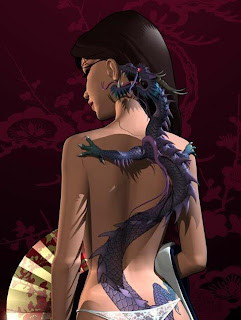The
Tintype of Dark Wonder is a magical artifact, often discovered at a carnival photography booth or in the possession of a street photographer. The photographer will not have taken the picture himself, nor will he know how it has come to be among his wares. It’s usually sold cheaply.
The small cult who follows the picture's movements, and chronicles them in iterations of the mimeographed or photostatted tract known as
The Menagerie Grotesque, holds that it has its origins in drowned Meropis. No serious scholars view the cult as anything more than a collection of crackpots, so this, like all their other claims, are doubted. What is not in doubt, however, is that the item gives the possessor control over three magical entities, but at a price.
The possessor may summon the three, frankly ludicrous, animal caricatures pictured by simply holding the tintype, looking at the desired creature, and willing said creature to act in accordance with his will. When a creature is summoned it disappears from the picture, returning only when its task is complete. The creatures will act in the following manner:
The gluttonous frog: When called the frog will follow any individual the possessor wills. It will be invisible to all with magically aided vision but the possessor. The victim will find themselves with a growing appetite for food, sex, and other pleasures. Over time, these appetites will grow increasingly bizarre. The victim will gain weight, whether eating excessively or not. Over a period of 2-12 months they will become immensely fat and virtually immobile, and entirely depraved. A saving throw will allow the victim to intuit that they are under a curse. Remove curse will chase the frog away.
The lanky hound: When called, the hound begins harrying a victim. It will only be visible to the victim, the photo’s possessor, and those with magical sight. The hound will always stay far enough away from the victim so that it is a vague shape in the distance, or perhaps a distorted figure in the fog, glimpsed by peripheral vision. The hound's presence will cause the victim increasing feelings of dread and paranoia. Within a week, they will be suffering the effects of poor sleep. Within two, they will be unable to perform in any critical situations and be essentially homebound by fear--only being able to leave with a successful Wisdom check. The victim seeking out the hound and chasing it, will drive it away for a time, but it will return in 1d4 days. Only remove curse or the like will drive it away permanently. After 1d4 months, only a saving throw will keep the victim from attempting to end their own life.
The twisted eel: The twisted eel causes the degeneration of the body of the victim, by progressive nerve death, and crippling arthritis. The victim will feel the eel's cold-blooded presence but only the possessor and the magically sighted see it. After a 1-6 days of the eel’s influence, pain will cause a -1 to all roles involving physical aptitude. After 2d4 weeks, dexterity and strength will begin to be reduced at a rate of 1 point a week. Healing magic will stave off loss for that week, but not halt the degeneration. When strength and dexterity are reduced to zero, constitution begins to decline at a rate of one point a day. Once again, remove curse or the like will drive away the eel. If the eel is driven off before a score reaches zero, it will fully heal with time.
Death of the one who summoned the creature will also end its attack. If a remove curse drives the creature from its intended target, it will attempt to attack the possessor instead, unless a successful saving throw is made. Each possessor may only summon each creature once, after that the picture seems to be just a picture....except for the untoward attention it brings to the possessor from extraplanar entities, and sorcerous collectors eager to add the tintype to their collections.


























































